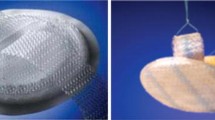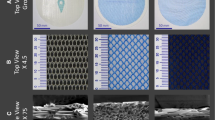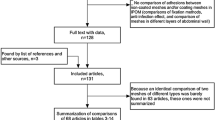Abstract
Introduction
Mesh-related adhesions are a significant clinical problem following intraperitoneal mesh placement. In this study, we evaluated adhesion formation to three relatively new meshes for intraperitoneal use.
Methods
Three new meshes for intraperitoneal use (Omyra® mesh, Physiomesh®, and Hi-Tex Endo-IP®) were implanted intraperitoneally in rats and compared with a polypropylene control mesh (Parietene®) after 7 or 90 days. Adhesion formation, incorporation (tensile strength), shrinkage, and foreign body reaction were scored.
Results
Hi-Tex Endo-IP and Physiomesh® showed significantly less adhesion formation when compared to Parietene at both time points (p < 0.05). Shrinkage was highest in Omyra mesh after 90 days, which was significantly more compared to Parietene® (p < 0.001). Physiomesh® only showed a significant reduction in craniocaudal mesh length, compared to Parietene and Hi-Tex Endo-IP (p < 0.05). After 90 days, Hi-Tex Endo-IP® showed significantly higher and Physiomesh® significantly lower incorporation strengths compared to all other groups (p < 0.05). Microscopic evaluation revealed massive foreign body reaction to Hi-Tex Endo-IP®, leading to an extensive and thick collagenous scar adherent to the abdominal wall. Fractioning of the Physiomesh® coating over time led to an increase in interfilamentary granuloma formation, leading to scar plate formation, but with only minimal to no abdominal wall adherence. Both Parietene® and Omyra® showed a mild foreign body response.
Conclusion
Although clear distinctions can be made between meshes and some meshes excel, none of the meshes are superior in all aspects required for effective and safe incisional hernia repair.




Similar content being viewed by others
Literature
Kingsnorth A, LeBlanc K (2003) Hernias: inguinal and incisional. Lancet 8(362):1561–1571
Poulose BK, Shelton J, Phillips S, Moore D, Nealon W, Penson D et al (2012) Epidemiology and cost of ventral hernia repair: making the case for hernia research. Hernia 16:179–183
Burger JWA, Luijendijk RW, Hop WCJ, Halm JA, Verdaasdonk EGG, Jeekel J (2004) Long-term follow-up of a randomized controlled trial of suture versus mesh repair of incisional hernia. Ann Surg 240:578–583 discussion 583–585
Dumanian GA (2012) Discussion: adhesions and meshes: synthetic versus bioprosthetic. Plast Reconstr Surg 130:214S–215S
Helgstrand F, Rosenberg J, Kehlet H, Jorgensen LN, Bisgaard T (2013) Nationwide prospective study of outcomes after elective incisional hernia repair. J Am Coll Surg 216:217–228
Huang C-C, Lien H-H, Huang C-S (2013) Long-term follow-up of laparoscopic incisional and ventral hernia repairs. J Laparoendosc Adv Surg Tech A 23:199–203
Jenkins ED, Yom V, Melman L, Brunt LM, Eagon JC, Frisella MM et al (2010) Prospective evaluation of adhesion characteristics to intraperitoneal mesh and adhesiolysis-related complications during laparoscopic re-exploration after prior ventral hernia repair. Surg Endosc 24:3002–3007
Demir U, Mihmanli M, Coskun H, Dilege E, Kalyoncu A, Altinli E et al (2005) Comparison of prosthetic materials in incisional hernia repair. Surg Today 35:223–227
Turza KC, Butler CE (2012) Adhesions and meshes: synthetic versus bioprosthetic. Plast Reconstr Surg 130:206S–213S
Ellis H, Moran BJ, Thompson JN, Parker MC, Wilson MS, Menzies D et al (1999) Adhesion-related hospital readmissions after abdominal and pelvic surgery: a retrospective cohort study. Lancet 1(353):1476–1480
Van Der Krabben AA, Dijkstra FR, Nieuwenhuijzen M, Reijnen MMPJ, Schaapveld M, van Goor H (2000) Morbidity and mortality of inadvertent enterotomy during adhesiotomy. Br J Surg 87:467–471
Schreinemacher MHF, van Barneveld KWY, Dikmans REG, Gijbels MJJ, Greve JWM, Bouvy ND (2013) Coated meshes for hernia repair provide comparable intraperitoneal adhesion prevention. Surg Endosc 27:4202–4209
Schreinemacher MHF, Emans PJ, Gijbels MJJ, Greve JWM, Beets GL, Bouvy ND (2009) Degradation of mesh coatings and intraperitoneal adhesion formation in an experimental model. Br J Surg 96:305–313
Conze J, Rosch R, Klinge U, Weiss C, Anurov M, Titkowa S et al (2004) Polypropylene in the intra-abdominal position: influence of pore size and surface area. Hernia 8:365–372
Novitsky YW, Harrell AG, Cristiano JA, Paton BL, Norton HJ, Peindl RD et al (2007) Comparative evaluation of adhesion formation, strength of ingrowth, and textile properties of prosthetic meshes after long-term intra-abdominal implantation in a rabbit. J Surg Res 140:6–11
Sanders DL, Kingsnorth AN (2012) Prosthetic mesh materials used in hernia surgery. Expert Rev Med Devices 9:159–179
Brown CN, Finch JG (2010) Which mesh for hernia repair? Ann R Coll Surg Engl 92:272–278
Klinge U, Park J-K, Klosterhalfen B (2013) The ideal mesh? Pathobiology 80:169–175
Greca F, Paula J, Biondo-Simões M, Costa F, Silva A, Time S et al (2001) The influence of differing pore sizes on the biocompatibility of two polypropylene meshes in the repair of abdominal defects. Hernia 5:59–64
Cobb WS, Kercher KW, Heniford BT (2005) The argument for lightweight polypropylene mesh in hernia repair. Surg Innov 12:63–69
Sanders DL, Waydia S (2013) A systematic review of randomised control trials assessing mesh fixation in open inguinal hernia repair. Hernia 18:165–176
Hollinsky C, Kolbe T, Walter I, Joachim A, Sandberg S, Koch T et al (2010) Tensile strength and adhesion formation of mesh fixation systems used in laparoscopic incisional hernia repair. Surg Endosc Interv Tech 24:1318–1324
Beldi G, Wagner M, Bruegger LE, Kurmann A, Candinas D (2011) Mesh shrinkage and pain in laparoscopic ventral hernia repair: a randomized clinical trial comparing suture versus tack mesh fixation. Surg Endosc 25:749–755
Zogbi L, Trindade EN, Trindade MRM (2013) Comparative study of shrinkage, inflammatory response and fibroplasia in heavyweight and lightweight meshes. Hernia 17:765–772
Eriksen JR, Gogenur I, Rosenberg J (2007) Choice of mesh for laparoscopic ventral hernia repair. Hernia 11:481–492
Fortelny RH, Petter-Puchner AH, Glaser KS, Offner F, Benesch T, Rohr M (2010) Adverse effects of polyvinylidene fluoride‐coated polypropylene mesh used for laparoscopic intraperitoneal onlay repair of incisional hernia. Br J Surg 97:1140–1145
Schreinemacher MHF, Henatsch D, van Barneveld K, Bouvy N (2010) The need for standardised animal models and scoring systems in assessing mesh biocompatibility. Hernia 14:335–336
Dubay DA, Wang X, Adamson B, Kuzon WM Jr, Dennis RG, Franz MG (2005) Progressive fascial wound failure impairs subsequent abdominal wall repairs: a new animal model of incisional hernia formation. Surgery 137:463–471
Bittner R, Bingener-Casey J, Dietz U, Fabian M, Ferzli GS, Fortelny RH et al (2014) Guidelines for laparoscopic treatment of ventral and incisional abdominal wall hernias (International Endohernia Society (IEHS)—part 1. Surg Endosc 28:2–29
Acknowledgments
We would like to thank B. Braun and Stöpler BV for providing two of the meshes required for this research. Furthermore, we would like to thank S. Hartmans for her assistance to this project.
Disclosure
Two of the meshes were kindly provided by B. Braun (Omyra® mesh) and Stöpler BV (Hi-Tex Endo-IP®). Authors R.R.M. Vogels, K.W.Y. van Barneveld, M.H.F. Schreinemacher, J.W.A.M. Bosmans, G. Beets, M.J.J. Gijbels, and N.D. Bouvy declare no conflict of interest and have no financial ties.
Author information
Authors and Affiliations
Corresponding authors
Rights and permissions
About this article
Cite this article
Vogels, R.R.M., van Barneveld, K.W.Y., Bosmans, J.W.A.M. et al. Long-term evaluation of adhesion formation and foreign body response to three new meshes. Surg Endosc 29, 2251–2259 (2015). https://doi.org/10.1007/s00464-014-3936-5
Received:
Accepted:
Published:
Issue Date:
DOI: https://doi.org/10.1007/s00464-014-3936-5




